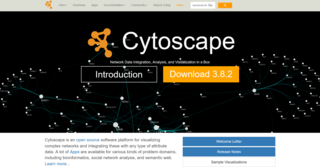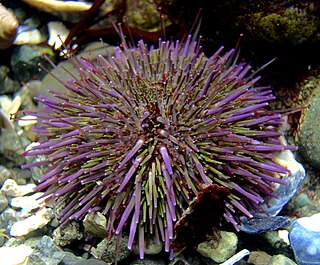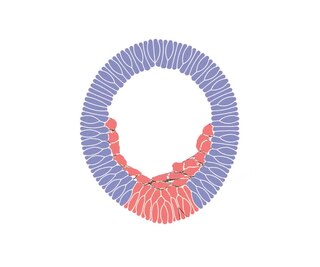Related Research Articles

Sea urchins are spiny, globular echinoderms in the class Echinoidea. About 950 species of sea urchin live on the seabed of every ocean and inhabit every depth zone from the intertidal seashore down to 5,000 meters. The spherical, hard shells (tests) of sea urchins are round and spiny, ranging in diameter from 3 to 10 cm. Sea urchins move slowly, crawling with tube feet, and also propel themselves with their spines. Although algae are the primary diet, sea urchins also eat slow-moving (sessile) animals. Predators that eat sea urchins include a wide variety of fish, starfish, crabs, marine mammals. Sea urchins are also used as food especially in Japan.

A generegulatory network (GRN) is a collection of molecular regulators that interact with each other and with other substances in the cell to govern the gene expression levels of mRNA and proteins which, in turn, determine the function of the cell. GRN also play a central role in morphogenesis, the creation of body structures, which in turn is central to evolutionary developmental biology (evo-devo).
Cis-regulatory elements (CREs) or Cis-regulatory modules (CRMs) are regions of non-coding DNA which regulate the transcription of neighboring genes. CREs are vital components of genetic regulatory networks, which in turn control morphogenesis, the development of anatomy, and other aspects of embryonic development, studied in evolutionary developmental biology.
Modularity refers to the ability of a system to organize discrete, individual units that can overall increase the efficiency of network activity and, in a biological sense, facilitates selective forces upon the network. Modularity is observed in all model systems, and can be studied at nearly every scale of biological organization, from molecular interactions all the way up to the whole organism.
Eric Harris Davidson was an American developmental biologist at the California Institute of Technology. Davidson was best known for his pioneering work on the role of gene regulation in evolution, on embryonic specification and for spearheading the effort to sequence the genome of the purple sea urchin, Strongylocentrotus purpuratus. He devoted a large part of his professional career to developing an understanding of embryogenesis at the genetic level. He wrote many academic works describing his work, including a textbook on early animal development.
Biological network inference is the process of making inferences and predictions about biological networks. By using networks to analyze patterns in biological systems, such as food-webs, we can visualize the nature and strength of interactions between species, DNA, proteins, and more.

Cytoscape is an open source bioinformatics software platform for visualizing molecular interaction networks and integrating with gene expression profiles and other state data. Additional features are available as plugins. Plugins are available for network and molecular profiling analyses, new layouts, additional file format support and connection with databases and searching in large networks. Plugins may be developed using the Cytoscape open Java software architecture by anyone and plugin community development is encouraged. Cytoscape also has a JavaScript-centric sister project named Cytoscape.js that can be used to analyse and visualise graphs in JavaScript environments, like a browser.

Strongylocentrotus purpuratus, the purple sea urchin, lives along the eastern edge of the Pacific Ocean extending from Ensenada, Mexico, to British Columbia, Canada. This sea urchin species is deep purple in color, and lives in lower inter-tidal and nearshore sub-tidal communities. Its eggs are orange when secreted in water. January, February, and March function as the typical active reproductive months for the species. Sexual maturity is reached around two years.
BioPAX is a RDF/OWL-based standard language to represent biological pathways at the molecular and cellular level. Its major use is to facilitate the exchange of pathway data. Pathway data captures our understanding of biological processes, but its rapid growth necessitates development of databases and computational tools to aid interpretation. However, the current fragmentation of pathway information across many databases with incompatible formats presents barriers to its effective use. BioPAX solves this problem by making pathway data substantially easier to collect, index, interpret and share. BioPAX can represent metabolic and signaling pathways, molecular and genetic interactions and gene regulation networks. BioPAX was created through a community process. Through BioPAX, millions of interactions organized into thousands of pathways across many organisms, from a growing number of sources, are available. Thus, large amounts of pathway data are available in a computable form to support visualization, analysis and biological discovery.
The ConsensusPathDB is a molecular functional interaction database, integrating information on protein interactions, genetic interactions signaling, metabolism, gene regulation, and drug-target interactions in humans. ConsensusPathDB currently includes such interactions from 32 databases. ConsensusPathDB is freely available for academic use under http://ConsensusPathDB.org.

A biological network is a method of representing systems as complex sets of binary interactions or relations between various biological entities. In general, networks or graphs are used to capture relationships between entities or objects. A typical graphing representation consists of a set of nodes connected by edges.

A cellular model is a mathematical model of aspects of a biological cell, for the purposes of in silico research.

Eucidaris tribuloides, the slate pencil urchin, is a species of cidaroid sea urchins that inhabits littoral regions of the Atlantic Ocean. As a member of the basal echinoid order Cidaroida, its morphological, developmental and molecular genetic characteristics make it a phylogenetically interesting species.

Ingression is one of the many changes in the location or relative position of cells that takes place during the gastrulation stage of embryonic development. It produces an animal's mesenchymal cells at the onset of gastrulation. During the epithelial–mesenchymal transition (EMT), the primary mesenchyme cells (PMCs) detach from the epithelium and become internalized mesenchyme cells that can migrate freely.
Natural computing, also called natural computation, is a terminology introduced to encompass three classes of methods: 1) those that take inspiration from nature for the development of novel problem-solving techniques; 2) those that are based on the use of computers to synthesize natural phenomena; and 3) those that employ natural materials to compute. The main fields of research that compose these three branches are artificial neural networks, evolutionary algorithms, swarm intelligence, artificial immune systems, fractal geometry, artificial life, DNA computing, and quantum computing, among others.
Skeletogenesis is a key morphogenetic event in the embryonic development of vertebrates and is of equal, although transient, importance in the development of the sea urchin, a marine invertebrate. The larval sea urchin does not resemble its adult form, because the sea urchin is an indirect developer, meaning its larva form must undergo metamorphosis to form the juvenile adult. Here, the focus is on skeletogenesis in the sea urchin species Strongylocentrotus purpuratus, as this species has been most thoroughly studied and characterized.
GeneNetwork is a combined database and open-source bioinformatics data analysis software resource for systems genetics. This resource is used to study gene regulatory networks that link DNA sequence differences to corresponding differences in gene and protein expression and to variation in traits such as health and disease risk. Data sets in GeneNetwork are typically made up of large collections of genotypes and phenotypes from groups of individuals, including humans, strains of mice and rats, and organisms as diverse as Drosophila melanogaster, Arabidopsis thaliana, and barley. The inclusion of genotypes makes it practical to carry out web-based gene mapping to discover those regions of genomes that contribute to differences among individuals in mRNA, protein, and metabolite levels, as well as differences in cell function, anatomy, physiology, and behavior.
geWorkbench is an open-source software platform for integrated genomic data analysis. It is a desktop application written in the programming language Java. geWorkbench uses a component architecture. As of 2016, there are more than 70 plug-ins available, providing for the visualization and analysis of gene expression, sequence, and structure data.
Echinobase is a Model Organism Database (MOD). It supports the international research community by providing a centralized, integrated web based resource to access the diverse and rich, functional genomics data of echinoderm evolution, development and gene regulatory networks.
In evolutionary biology, developmental bias refers to the production against or towards certain ontogenetic trajectories which ultimately influence the direction and outcome of evolutionary change by affecting the rates, magnitudes, directions and limits of trait evolution. Historically, the term was synonymous with developmental constraint, however, the latter has been more recently interpreted as referring solely to the negative role of development in evolution.
References
- ↑ Longabaugh WJR, Davidson EH, Bolouri H (2005). "Computational representation of developmental genetic regulatory networks". Dev. Biol. 283 (1): 1–16. doi: 10.1016/j.ydbio.2005.04.023 . PMID 15907831.
- ↑ Longabaugh WJR, Davidson EH, Bolouri H (2009). "Visualization, documentation, analysis, and communication of large-scale gene regulatory networks". Biochim. Biophys. Acta. 1789 (4): 363–74. doi:10.1016/j.bbagrm.2008.07.014. PMC 2762351 . PMID 18757046.